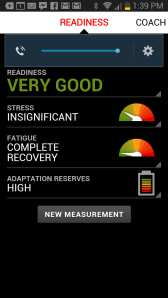Heart Rate Variability attempts to determine your level of preparedness as it relates to working out. It factors in stress, fatigue and adaptation reserves and gives you a path to proceed. We talk about the concepts of over training and rest a lot in the Eat To Perform Science Lab. If you are interested in finding out more about how you can perform better click here.
Let me start of this post by falling on my sword. I basically took the product out of the box. Started charging the chest piece and assumed it worked similar to the way a heart rate monitor works. It doesn’t and that was my mistake. Basically you put it up higher on your chest, the electrodes (on most heart rate monitors these are over your heart) are meant to be in your arm pits, for the best connection make sure they are wet. So basically after a conversation with support I have tested it 4 times and all times it worked flawlessly.
As it turns out the unit does not turn on until it makes a connection with your body (presumably to conserve the battery). Here are some additional instructions I received that might be helpful. Let me also say that Omegawave went way out of there way to accomodate me, which I am very grateful for because they are in Finland and I really really didn’t want to send this damn thing back to Finland;-)
“Below is the list of most common things that have cause problems to our customers:
– Transmitter can be placed wrong way on the charger and it does not get charged. You see only green light on the charger and you think it is charged, although it is empty. So please ensure the metal pins and dots between the transmitter and charger meet.
– Strap is too big. Electrodes need to be under your armpits.
– Electrodes are not wet enough. You need to rub the electrodes while rising them. Instead of measuring HRV or HR, we are measuring clinical grade ECG signal (noise max 20 micro volts) and thus we need mush lower resistance between the electrodes and the human body.
– Transmitter is upside down (text also upside down).
– Cannot pair (in bluetooth) the device. Some Android phones hide the PIN request so that you need PH.D. in computer science to pair the device while using the applications. In these cases it is better to pair the ECG sensor in the Android operating system (Settings -> Bluetooth).
– The transmitter is turned on only after finding human body (strap connected to human body). Some of our customers have been trying to pair the transmitter while having it in their hand without the strap.”








